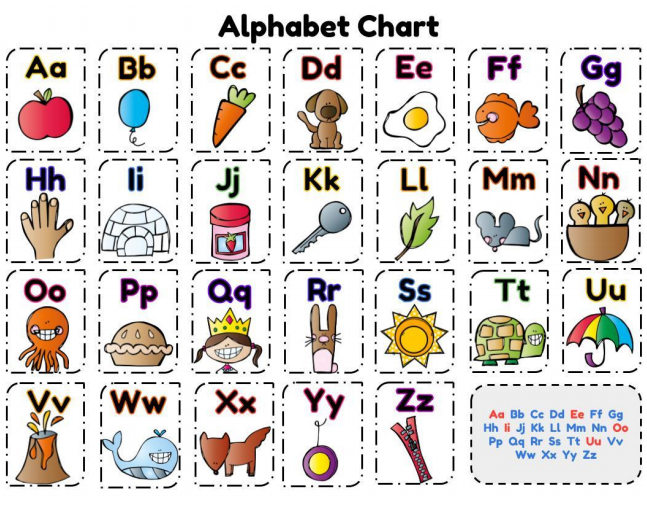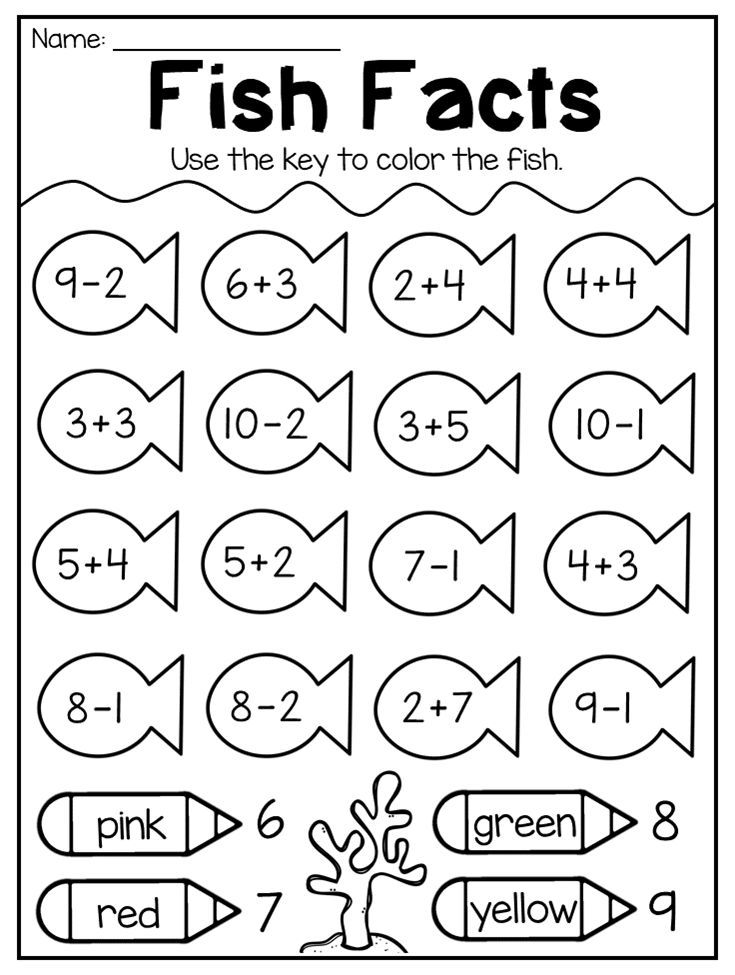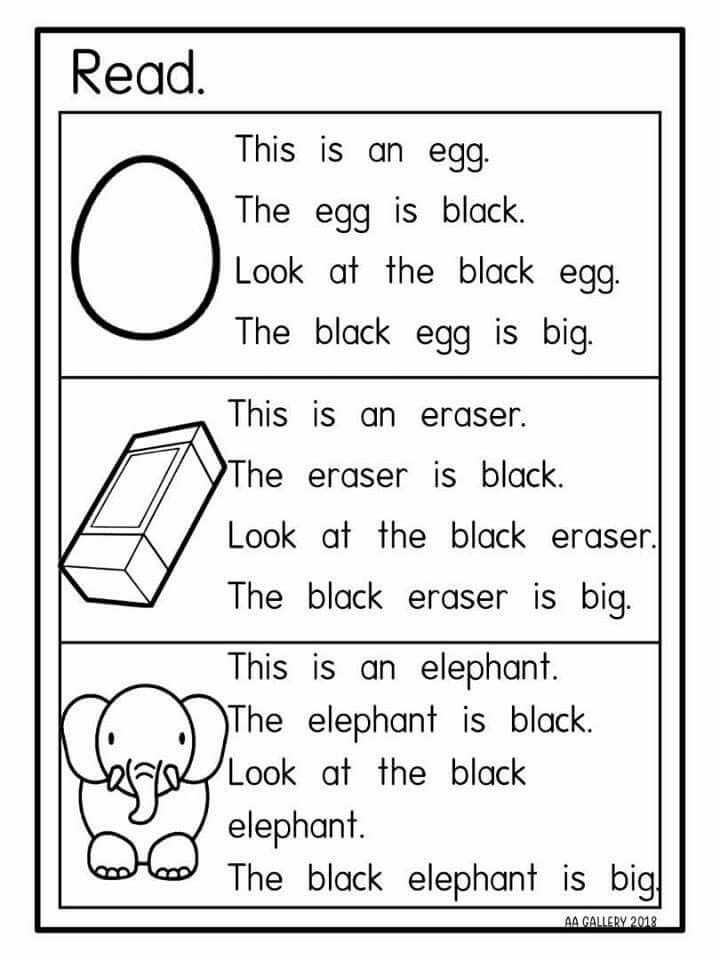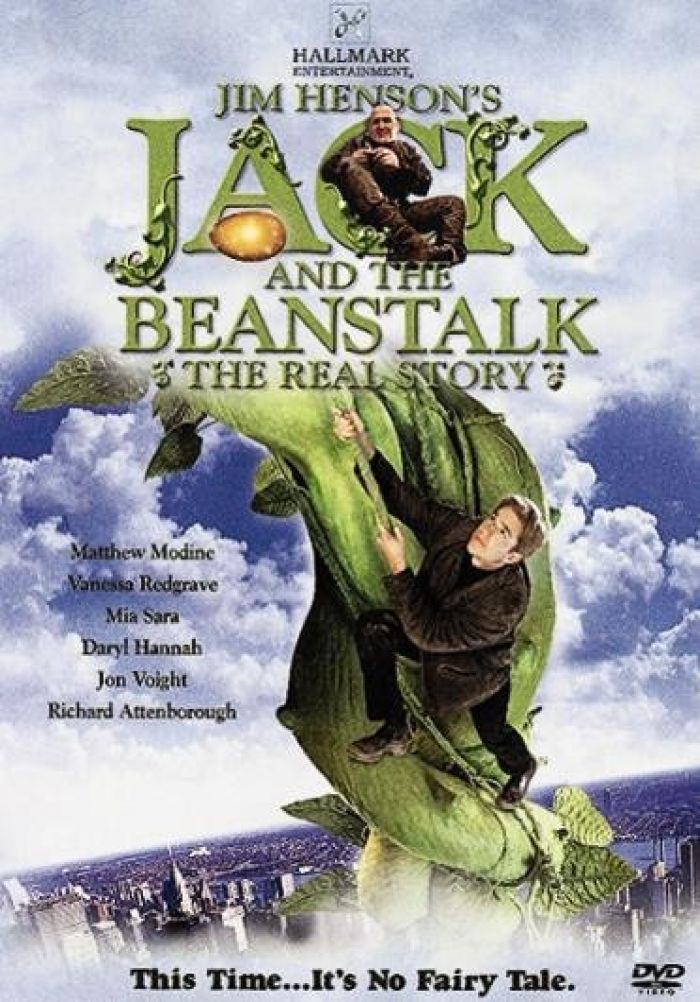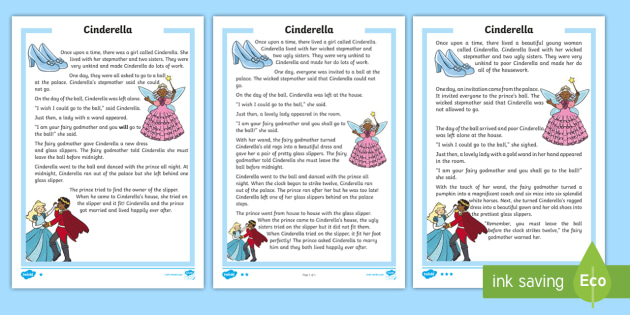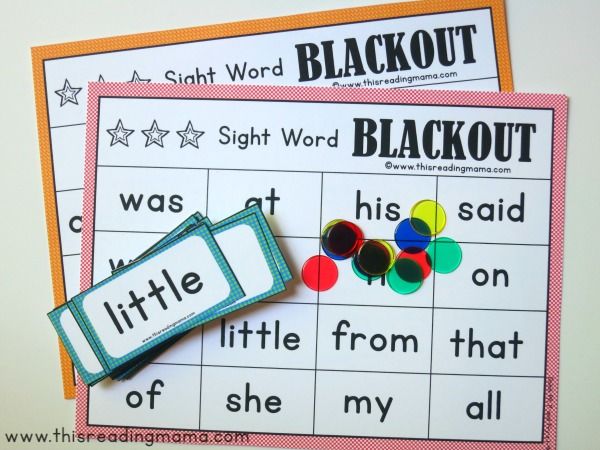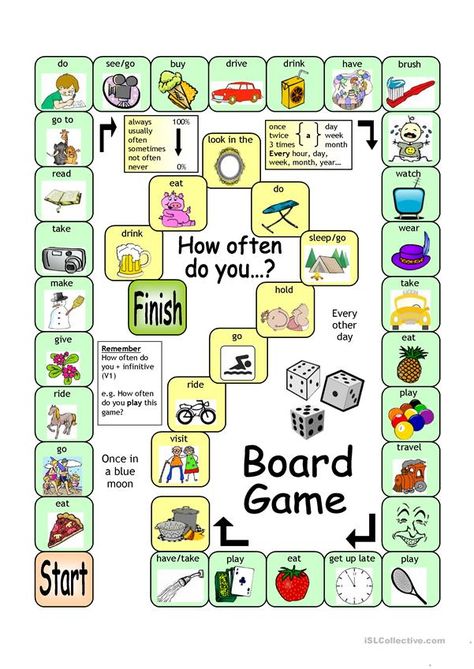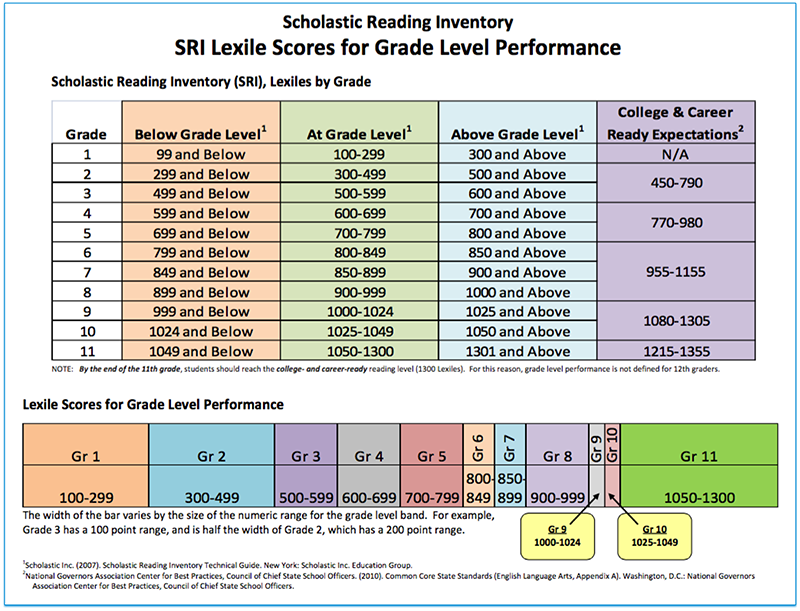Letter sounds lesson plan
Kindergarten Phonics Phonemic Awareness: Letter Sounds Lesson Plan
Objectives:
- Students will learn to identify initial consonant sounds and the letters that represent those sounds.
- Students will indicate awareness of consonant sounds and letters by responding with a physical movement.
About the Concept:
As students transition from phonemic awareness to phonological awareness, they acquire an important skill: the ability to convert sounds that are heard into the letters that represent those sounds. We begin the process of teaching letter/sound relationships with the consonants since they are more predictable than the vowels. For example, the consonant letter
b nearly always represents the beginning sound in the word ball, whereas the vowel letter a can be short (cat), long (made), or neither (ball). The auditory discrimination that students develop in preschool years or kindergarten prepares them for decoding and spelling words through phonics. This lesson plan uses music, rhythm, and play activities to encourage students to identify the beginning letter in words that they hear. Each time two words are sung in the question parts of the song, students respond by naming the initial consonant and by pointing to that letter on the charts, reinforcing the concept by including more of the total body in the learning experience. One way of singing the song in this lesson is to cover the box containing the letters at the bottom of each Mini-Chart page until the students have identified them. In this way, the song Who Knows the Letter? becomes a kind of guessing game with clues, giving students the feeling that they are playing, rather than learning. It should be stressed that, at this stage of development letter/sound matching is both an auditory skill and a visual one. In other words, students can not only name the letters that begin each target set of words, they also identify those letters in both capital and lower-case forms.
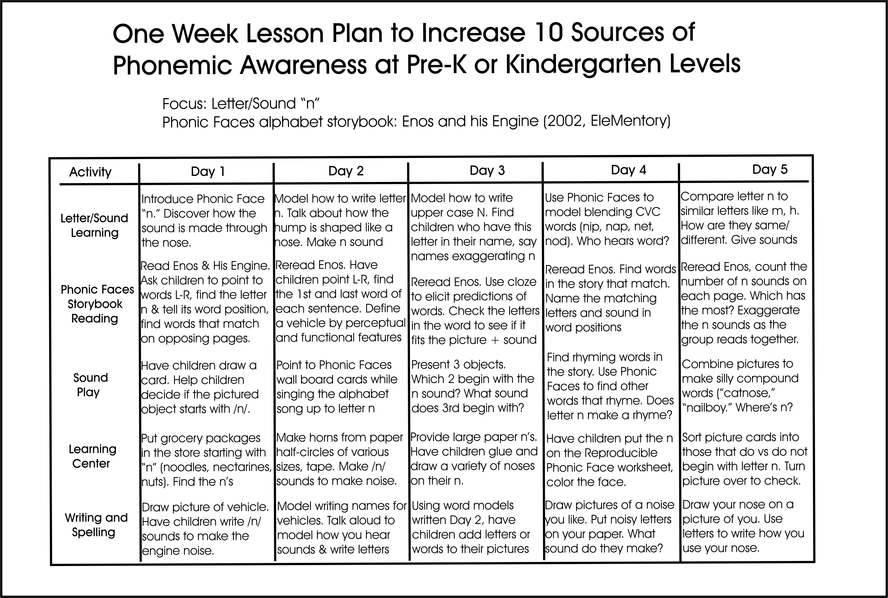 However, most students at this level do not generally have the skill level to read or spell all the words in the song. For students who can already read some simple words, song lyrics on the Mini-Charts can help build additional skills in spelling and reading. This lesson is the fifth in a series of five phonemic awareness lessons. The previous lesson, Kindergarten Phonics Phonemic Awareness: Sounding Out Words, teaches students to blend onset and rime into words. Once students have mastered the phonemic awareness skills in these five lessons, they can proceed to more advanced skills dealing with letters and sounds in
Sing Your Way Through Phonics Volume 1.
However, most students at this level do not generally have the skill level to read or spell all the words in the song. For students who can already read some simple words, song lyrics on the Mini-Charts can help build additional skills in spelling and reading. This lesson is the fifth in a series of five phonemic awareness lessons. The previous lesson, Kindergarten Phonics Phonemic Awareness: Sounding Out Words, teaches students to blend onset and rime into words. Once students have mastered the phonemic awareness skills in these five lessons, they can proceed to more advanced skills dealing with letters and sounds in
Sing Your Way Through Phonics Volume 1.
Materials:
- Sing Your Way Through Phonics Ready-to-Read! CD, Tracks 9 and 10 (Listen to audio sample)
- Sing Your Way Through Phonics Ready-to-Read! Mini-Charts (pp. 64-75)
- Capital and lower-case consonant letter cards Ex: B, b, D , d, F, f, L, l, M, m, N, n, P, p, R, r, T, t, V, v, W, w, Z, z
- Picture cards (that can be paired with initial consonant letter cards above) Ex: Bananas (B or b), Duck (D or d), Flowers (F or f), Jacket (J or j), Lion (L or l), Mittens (M or m), Newspaper (N or n), Pig (P or p), Rooster (R or r), Table (T or t), Violin (V or v), Zebra (Z or z)
- Small size sticky note pad
- Optional: Magnetic letter sets including upper and lower-case letters
Note: If you do not have the CD or Mini-Charts, you can still teach this letter sounds lesson plan using the folk tune listed on the Who Knows the Letter? Song Lyrics page. For this level, it is good practice to include pictures, for visual reinforcement.
For this level, it is good practice to include pictures, for visual reinforcement.
Find out more about Sing Your Way Through Phonics products.
Order our cost-saving Ready to Read Combo online.
Procedure:
- Say, “Today we are going to sing a song about letter sounds. First, let’s see if we recognize all the capital and lower-case letters we need for the song.” Play a Concentration or matching game using capital and lower-case letter cards or magnetic letters for Bb, Dd, Jj, Kk, Pp, Tt, Ss, Ff. For Concentration, mix up the cards and turn each of the letter cards face down. Allow a player to turn over two cards. The player must name the letter on each card. If capital/lower-case partners are turned over, the player keeps the cards and takes another turn. If overturned cards are not partners, cards are re-placed face down and the next player gets a turn.
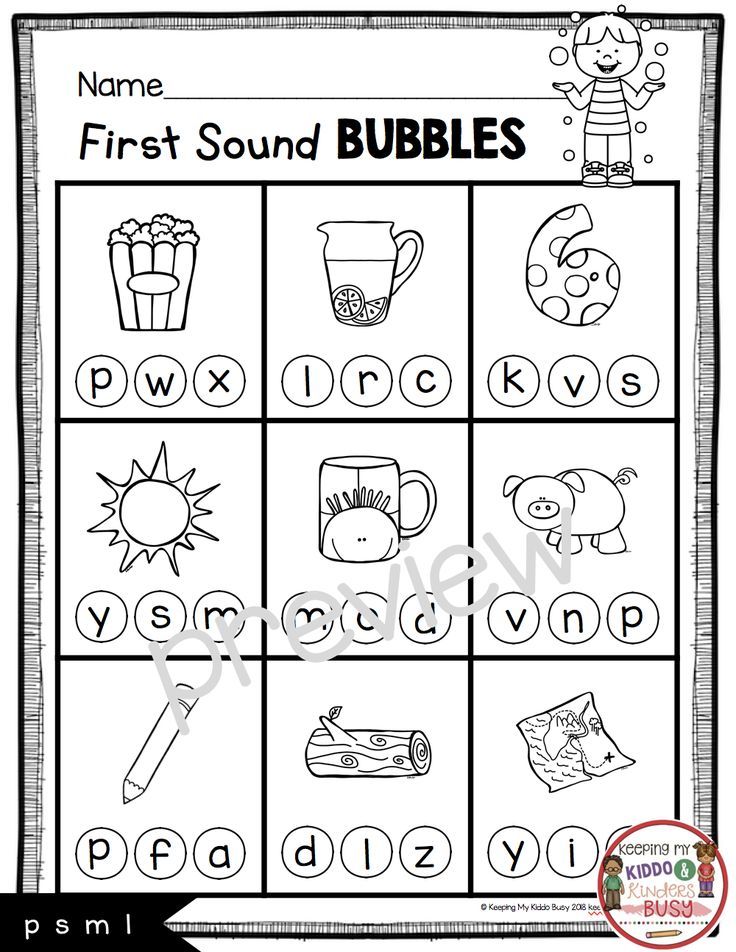 Play continues until all cards are matched. Player (or team) with the most matches wins. To play a matching game, scramble up the set of letter cards or magnetic letters. Students unscramble the letters by matching pairs of capital/lower-case letters. For added incentive, use a timer and have students try to beat their own or others’ completion time.
Play continues until all cards are matched. Player (or team) with the most matches wins. To play a matching game, scramble up the set of letter cards or magnetic letters. Students unscramble the letters by matching pairs of capital/lower-case letters. For added incentive, use a timer and have students try to beat their own or others’ completion time. - Turn to Mini-Chart page 64-65. Point to the picture of the boy with the ball. Enunciate very clearly and say, “Boy and ball both begin with what letter?” (B) Point to the box at the bottom of the page and say, “Notice that we can begin these words with either capital B or lower-case b.” Point to the picture of the dog with the dish. Enunciate very clearly and say, “Dog and dish both begin with what letter?” (D) Point to the box at the bottom of the page and say, “Notice that we can begin these words with either capital D or lower-case d.
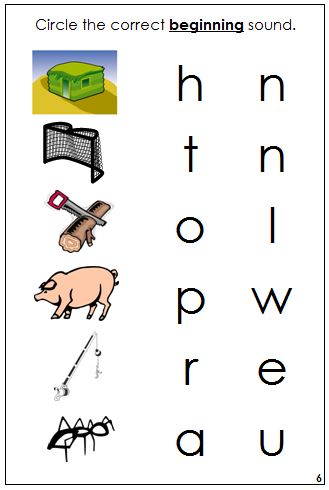 ”
” - Say, “Now we are going to learn a song about beginning letters in words. The song asks you a question about the pictures on each page. Let’s listen to the music and see if we can sing the correct answers to the questions. When you think you can sing along with the words, go ahead and join in the singing.”
- Play Track 9 of Sing Your Way Through Phonics Ready to Read! CD, pointing to the pictures and the letter boxes on Mini-Chart pages 64-75.
- Say, “Now, let’s practice this song again, and we’ll give some of you a chance to cover and uncover the boxes of beginning letters.” Choose two students to stand to the left and right sides of the Mini-Charts. Each student covers the letter box on his/her side of the charts. Each student uncovers the picture after the phrase, “They both begin with ___.” Play CD Track 9 again and assist the letter box coverers, if necessary, by guiding their hands and reminding them to turn pages as the song continues.
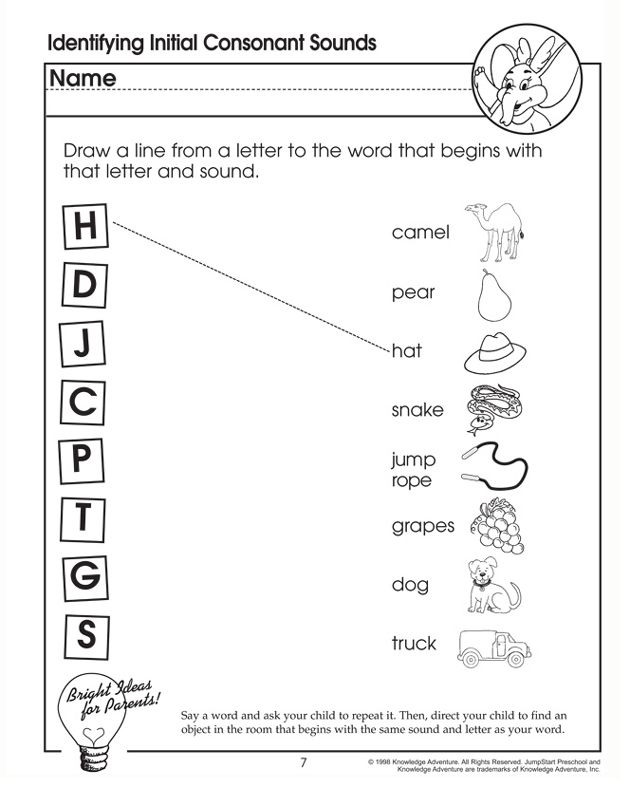
- Cover each letter box with a small sticky note on Mini-Chart pages 64-67 and 70-73. Sing the song again, but this time let students lift the sticky note to reveal the beginning letters instead of removing their hands.
- Give a letter card used in Step 1 to each child. If necessary, make enough duplicate copies so that every student is holding a letter. Ask each student to identify the capital or lower-case letter s/he is holding.
- Say, “Now we are going to sing this song one more time. But this time, we are going to leave the sticky notes covering the letter boxes. When we sing about things that begin with the letter you are holding, stand up and hold your letter card high.” Play CD Track 9 again and be sure that all students holding capital or lower-case forms of the beginning letters are rising “on cue.”
Follow-up:
- Practice singing Who Knows the Letter? every day for a week.
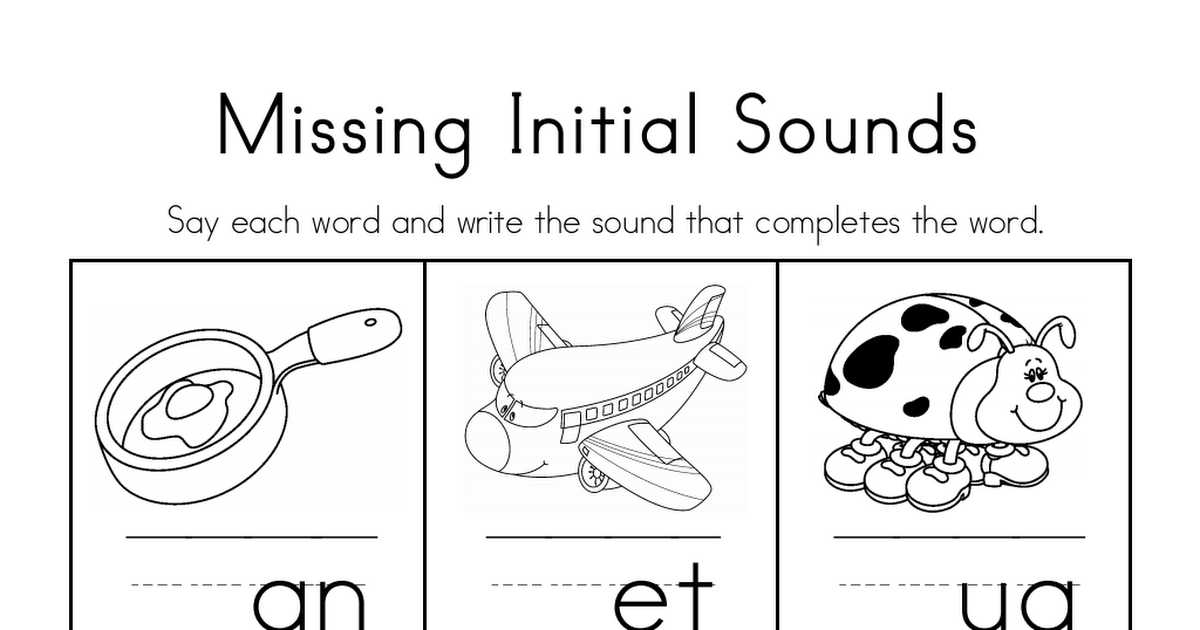 Then try singing the song with the instrumental track on the CD (Track 10). Do the students remember all the words to the song? Review any parts of the song that are giving them difficulty and use the pictures on the Mini-Charts to aid memory.
Then try singing the song with the instrumental track on the CD (Track 10). Do the students remember all the words to the song? Review any parts of the song that are giving them difficulty and use the pictures on the Mini-Charts to aid memory. - Help students create other sets of words for the song. Make 8 copies of Mini-Chart template page 88 and 2 copies of Mini-Chart templates pp. 89-91. At first, you might use only the consonants already in use, but change the pictures. Example: Replace boy and ball with bag and boat. Eventually, use the song to teach other initial consonants such as Gg (gorilla, gum), Hh (heart, hand), Ll (ladder, leaf), Mm (monkey, milk), Nn (nail, net), Qq (quilt, queen), Rr (rooster, rake), Vv (violin, vase), Ww (wagon, watch), Yy (yo-yo, yarn), and Zz (zebra, zipper).
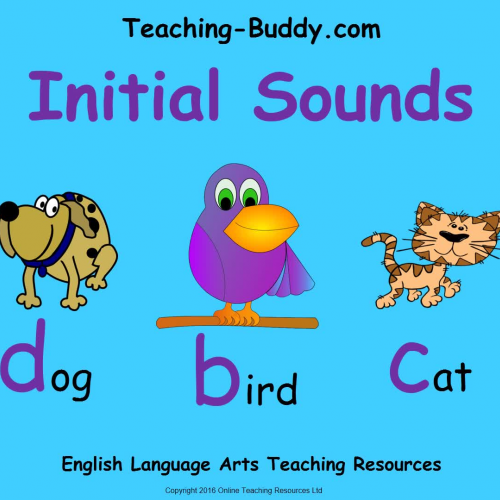 Pictures may be replaced with drawings, clip art, magazine cut-outs, or photos.
Pictures may be replaced with drawings, clip art, magazine cut-outs, or photos.
Extensions:
- Practice matching letters and beginning sounds by holding up a picture card and giving students a choice of two letter cards. Example: Picture of banana, letter cards B and J. Ask the students to echo you as you say the name of a picture and the name of a letter: “Banana-banana-B-B” and then “Banana-banana-J-J.” Point to the picture card and each letter card and say, “Which letter sounds like the beginning of banana--B or J?” (J)
- Repeat Step 2 with several more picture cards, always giving students a choice of two different letters for their choice of beginning sound. At first, use only capital letters. Gradually add lower-case letters if students succeed in correctly naming the beginning letter for most of the pictures.
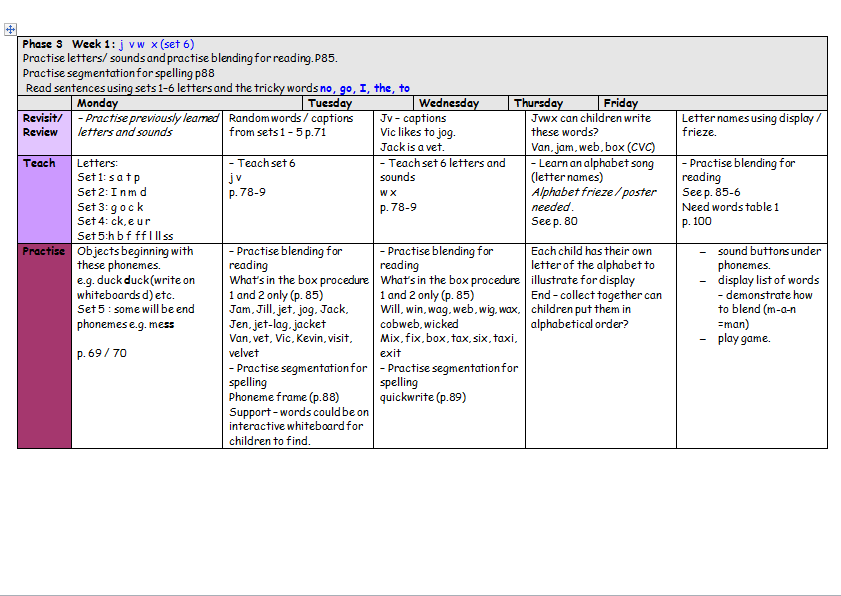
- Use the instrumental track of the song to create a themed song using describing words (ex. l=little and light, s=sunny and strong, b=bumpy and big), action words (ex. j=jump and jog, c=creep and crawl, r=run and reach, b=bend and bounce), animals (ex. b=bear and bee, d=deer and dog, f=fox and flea, l=lion and lamb).
- Sing Guess Who Knows the Letter? and add the ASL hand signs for the beginning letters. A printable chart is available at http://www.enchantedlearning.com/language/asl/abc/print.shtml
- Students who are ready to read simple words can help spell or write words created for the song’s instrumental track.
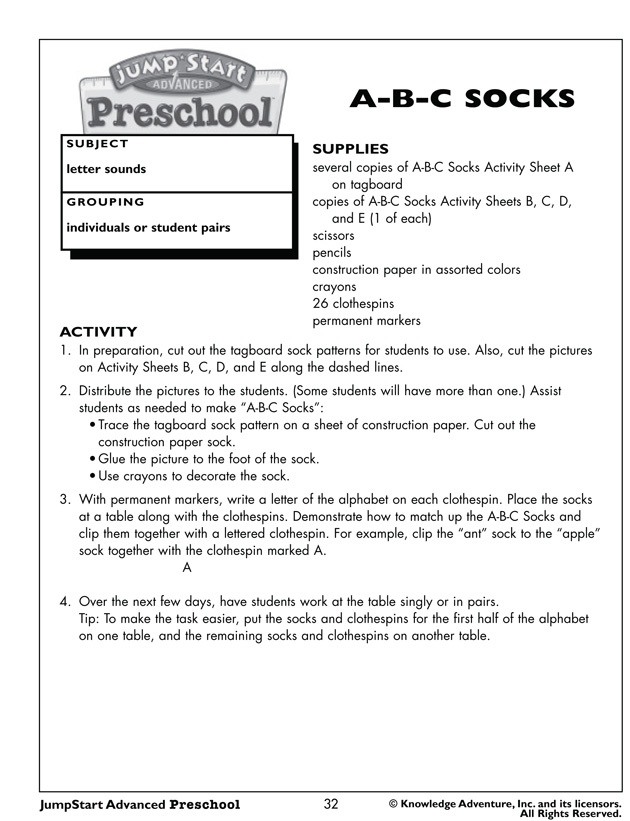 They can also try reading the original words for the song, since there is much repetition
They can also try reading the original words for the song, since there is much repetition
Evaluation:
- Students sing all the words to the song on Mini-Charts pp. 64-75 without assistance, or
- Students indicate ability to identify beginning consonants by correctly singing the beginning letters when the letter boxes in the song are covered.
Order our cost-saving Sing Your Way Through Phonics Ready to Read Combo online ($33.95) containing the CD, Mini-Charts, Song Lyrics, and Teaching Suggestions — everything you need for this lesson! Or, print out an order form to mail/FAX to us.
Letters and Sounds Lesson Plans
Letters and Sounds Lesson Plans
|
- ABC Detectives- Students will alphabetize words according to the first letter while pretending to be detectives with magnifying glasses. Your students will also be working on their social skills and character development when working with their teams and partners.
- ABC Rhyme Time- After producing a word family list, students will put the list in ABC order.
- ABC's Transformer- This activity allows students to design their own letter graph, and then produce the resulting graphs after a translation, reflection, and rotation.
- Beginning Sound Flashcard Game - The student will be able to name common objects in English by verbally identifying pictures of common objects.
- Beginning Sound Game - This cooperative learning structure was chosen because of the type of lesson and desired group structure.
- Blending - They will select letter patterns and know how to translate them into spoken language by using phonics, syllabication, and word parts.
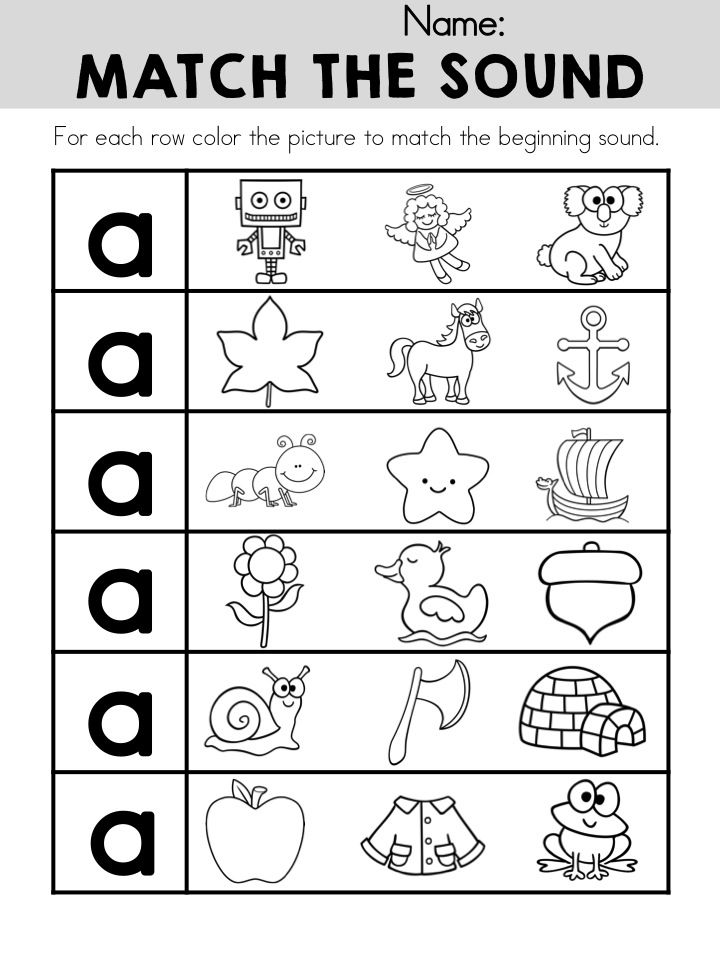
- Building With Blends- The students learn how to blend sound components into words by completing a whole group activity with the teacher. They then use this knowledge in a station activity game where they match word parts with blends to form complete words.
- Connecting Sounds with Letters - The Letter 'b' and the sounds it makes which creates words, naming familiar things in our environment.
- Consonant Blends - Getting kids to blend sounds to make words is an essential step in learning to read.
- I Can Make a Pattern, You Can Make a Pattern- Patterns, patterns everywhere! Can you make a pattern? Students will make a physical pattern using sounds, physical movements, and manipulatives.
- Good Vibrations - The goal of this lesson would to have the students be able to read the book in groups and then try out the different tools that make vibrations, and sounds.
- Learning Letters/Sounds -To teach the pupil the letters of the alphabet and to becoming automatic in alphabet sequencing.
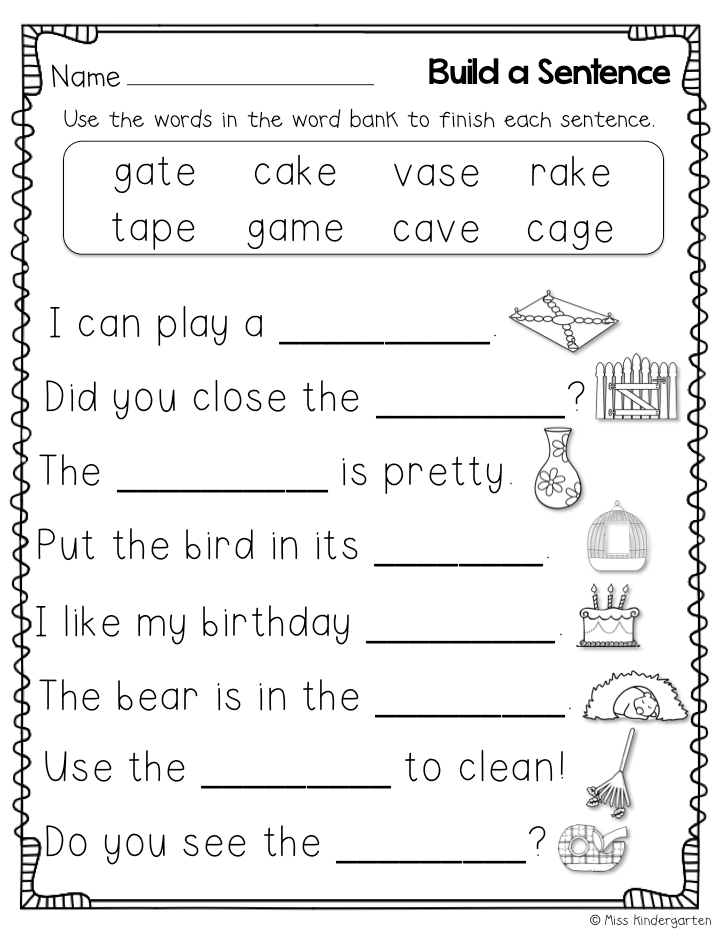
- Learning Letters and Sounds - Learning sounds of letters with pictures and textures.
- Let's Visit Letter Land- Students listen to a narrative story of how the letters learn what alphabetical order is when the letters can't figure out who should start the Letter Land Parade.
- Letters and Sounds; M & O - Students will identify the letters M and O Student will identify the sounds for /M/ and short-/O/ .
- Letter and Sound of Mm - Know the sound letter Mm makes, be able to tell and identify words that start with letter Mm.
- Letters Alive, Oh, My!- I write A, you write A A A A . This lesson helps students form the letter Aa.
- Letters Everywhere! - Students will be able to sound out the blend sounds that are shown in diagrams with 90 percentage points of accuracy and relation.
- Learning the Short "e" Sound - This lesson will help students recognize and respond to the sound of the short "e" sound.
- Names Count!- Using the number of letters in their names and in fairy tale characters' names, students work in small groups to complete a graph and use data to determine range, mode, and median.
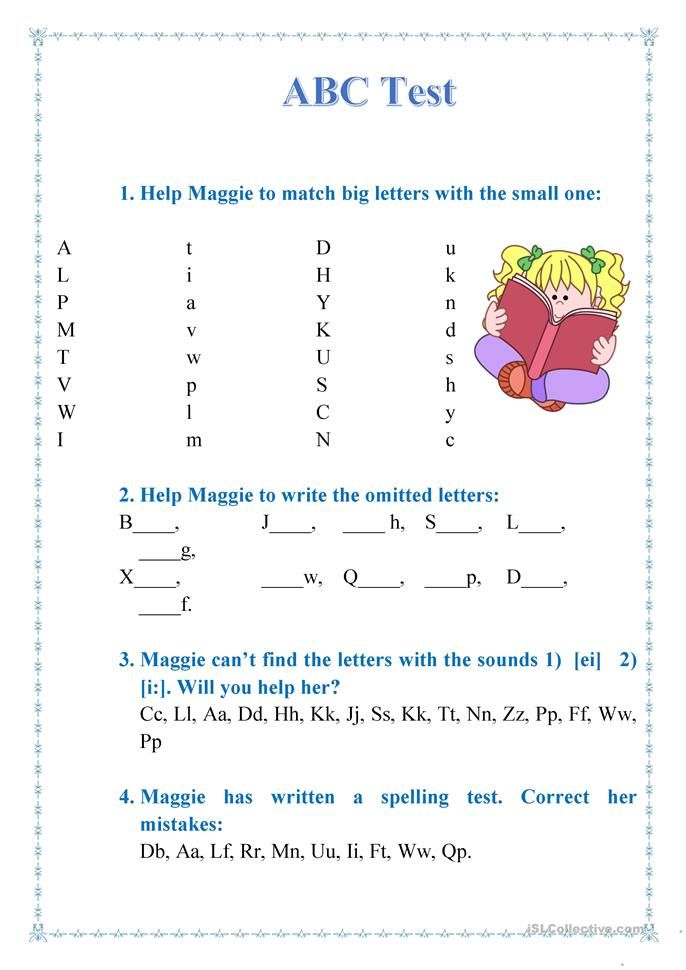
- Ordering the Alphabet- Students learn how to order the letters in the alphabet using twenty words, using names of objects found at home and school, names of animals, and color words.
- Quick and Sticky Context Clues- This lesson shows students how to use beginning sounds and context clues to determine what an unknown word is.
- Rhyming Words/Beg. Sounds - The teacher will use CRF templates and maps to maintain systematic and explicit instruction.
- Short e vowel Sounds - Students will read the list of short e words and select the word that explains the picture.
- Short-Vowel Sounds - Read and be able to identify words that have short-vowel sounds.
- Sound Detective- Students listen for a particular letter sound and decide whether it is at the beginning, middle or end of a word.
- Sound Search- This lesson is for students working on letter/sound recognition.
- Sounds Like Homonyms - The students will understand what Homonyms are and give specific examples.
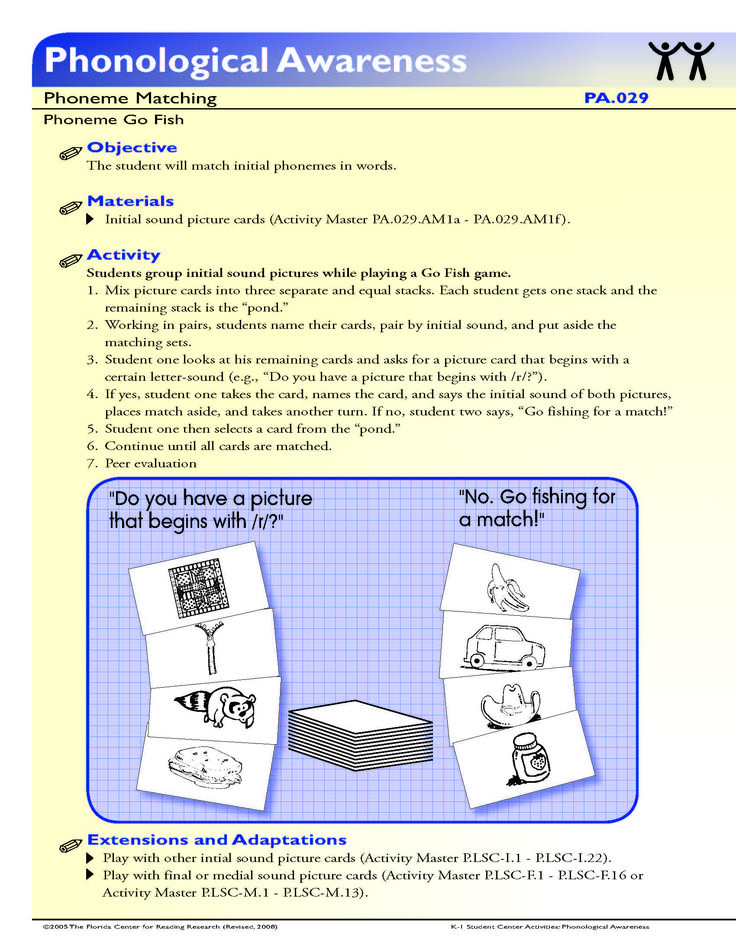
- Teaching sh, ch, ck, and th - The learner will apply phonics and structural analysis to decode words.
- The Vowel Slide- Students will learn that every word must have a vowel.
- Using Phonics to Increase Reading Speed - To teach the students the association of sound with letter (printed symbols).
Sounds and letters. | Outline of the lesson in the Russian language (Grade 1):
Topic. Sounds and letters.
Objectives: to clarify the idea of the essential features of sounds and letters; learn to compare the sound and letter designation of words.
Expected results: students will learn to recognize the conventions of speech sounds; apply the acquired knowledge in the performance of tasks.
Equipment: textbook "Russian language" grade 1 author Kanakina V.P., printed notebook for the textbook, notebook, computer, cards for working in pairs, network card for final repetition, goldfish.
Course of the lesson:
I.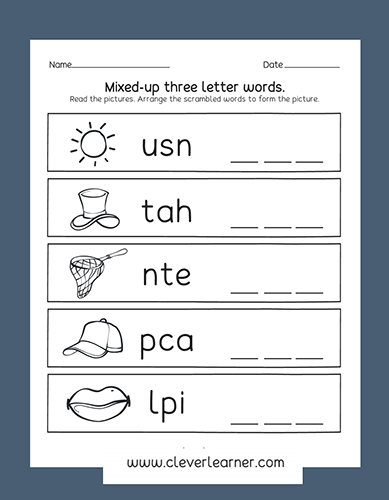 Organizational moment.
Organizational moment.
-Check, my friend,
Are you ready to start the lesson?
Is everything in place, is everything in order
Books, pens and notebooks?
Have you checked? Sit down!
Work diligently!
- Guys, what lesson are we having now? /Russian language lesson/
-Why do we need to learn Russian? /To be literate people/
II. Calligraphy
- A literate person should be able to write beautifully and correctly. To continue learning we need notebooks.
-I'll open my notebook /Open notebooks/
And put it down. / Lay obliquely /
I, my friends, will not hide from you - / They take pens /
I hold the pen like this. / They put my hand on my elbow and show how to hold the pen correctly /
notebook, posture check/
I'll get to work. /Write the number, classwork/
- In the spring, the snow melts, turning into water, the water flows to the rivers, overflowing and flooding the nearby lands. This natural phenomenon is called high water, high water. /Display on screen/
This natural phenomenon is called high water, high water. /Display on screen/
-Water flows in waves. For a moment of calligraphy, a wave looked at us.
- Look, what letter is hidden in the wave? / p / Transfer the wave to your notebook and continue it to the end of the line.
- What letter do the words flood begin with. high water? / On p / Write down these words beautifully in your notebook. /The words are printed, the teacher writes in written letters on the blackboard/
- This time is very dangerous for life. Every year people die during floods. Water closes the lowlands, depressions. We do not see a place where we can stand, so we can drown. The ice is weak, you can't go out on it. You can only walk near the house, on a hill.
III. Self-determination to activity.
-Spring. We go out into the street and the sounds of spring surround us everywhere: streams murmur, birds sing, children scream, launching boats. Everyone is happy with the sun and spring.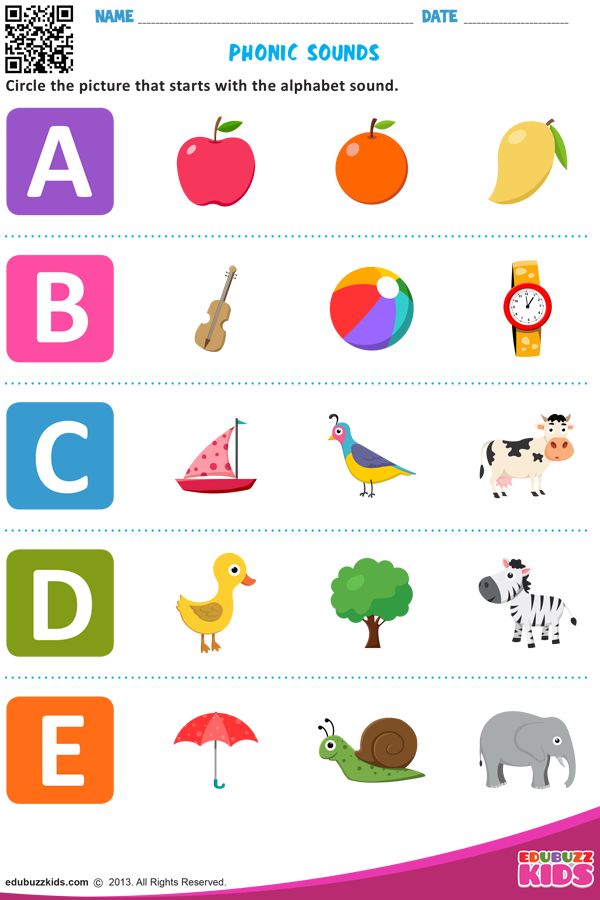 And it gets so good. /The sounds of spring sound in the recording/
And it gets so good. /The sounds of spring sound in the recording/
- What two groups can the sounds around us be divided into? /Speech and non-speech/
- We are not letters, we are speech sounds
Studying phonetics of us.
We are not letters, we are speech sounds
They pronounce and hear us.
Breathing freely in every vowel,
In a consonant - interrupted for a moment.
And only he achieved harmony,
To whom their alternation is subject.
- Who guessed what the lesson will be about?
- Today we will talk about sounds and letters. Open the textbooks on p.45. Read the topic of the lesson. /Sounds and letters/
- What will we learn when studying this topic? /Read on p.45/
The teacher reads the information on p.47 in the heading "Pay attention!"
IV. Work on the topic of the lesson.
- Now sit down freely and listen to a fairy tale about sounds and letters.
-Once upon a time there were sounds in one magical land.
The teacher puts a card with the word “SOUNDS” on the board.
- The country was tiny, there were few inhabitants. Nobody saw them, because they were invisible. their melodiousness and vociferousness they were called .../vowels/.0003
- Right. Sounds and now live together. And then one day a wizard appeared in this country. He liked it so much that he wanted to get to know its inhabitants better. But they were invisible. Then he decided to give each inhabitant clothes. As soon as you put it on, sounds become visible and turn into letters.
The teacher puts a card with the word “LETTERS” on the board.
- Guys, what is the difference between sounds and letters? /Children's answers/
Work with the textbook. Exercise #2 p.46
-Read the assignment. Let's make a sentence about sounds using the ready beginning and words for reference, and then write it down in a notebook.
Sounds we hear and pronounce.
/ Make up a proposal under the guidance of a teacher. They write it down in their own notebook. /
They write it down in their own notebook. /
- In the last lesson we studied the role of stress in words. What sounds are stressed with? /With vowels/
-Thanks to this friendship, what do vowels become? /impact and non-impact/
The teacher puts on the board cards with the words “STRESSED” and “UNSTRICTED”
- Let's find out everything about consonant sounds. What are the consonants? /voiced, deaf, hard, soft/
The teacher puts on the board cards with the words “VOICED”, “DEAF”, “HARD”, “SOFT”.
on the board turned out to be a table:
Sounds of the letter
Vowel consonants
impassable voiced deaf
hard soft firm soft
- so that the wizard could have fun gave them carnival outfits in the form of circles. Which vowels and which consonants did they get? /Children answer/
On the board under the table, symbolic designations of sounds appear (taken from the "School 2100" system).
V. Sound-letter analysis of words.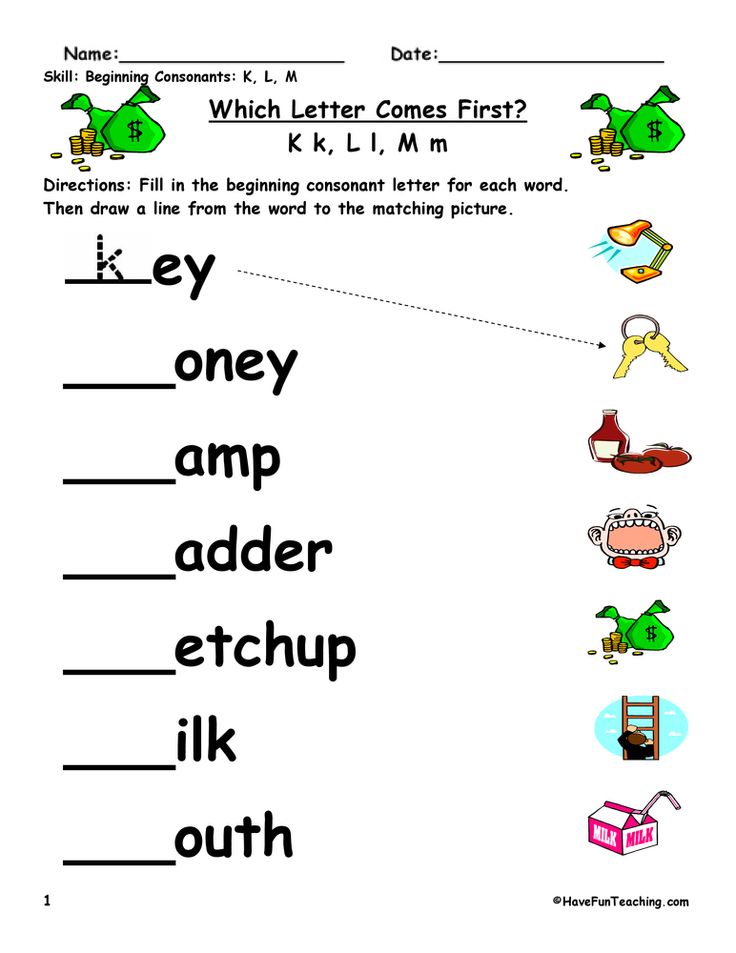
Work with the textbook. Exercise No. 4 p. 47 - perform in rows.
/One representative from a row works at the board on type-setting canvases, upon completion of the check/.
- Let's try to dress up the words that we see in the form of pictures in multi-colored carnival costumes and letter clothes.
- Look at the pictures. Who is depicted on them? /Stork, elephant, catfish/
-Make a sound scheme of words from circles, write the word in letters through a dash.
-Let's check if everyone coped with the task?
- Do the words have the same number of sounds and letters?
Physical education session
Physical education session with movements.
The water is quietly splashing,
We are floating on a warm river. (Swimming movements with the hands.)
There are clouds in the sky, like sheep,
They fled in all directions. (Sipping - hands up and to the sides.)
We get out of the river,
To dry off, we will take a walk. (Walking in place.)
(Walking in place.)
Now take a deep breath.
And sit down on the sand. (Children sit at their desks.)
Children do eye exercises to the sounds of nature. Children remain seated at their desks.
-Eyes need to rest. /Guys close their eyes/
-You need to take a deep breath. /Deep breath. Eyes are still closed /
- Eyes will run in a circle. /Eyes open. Movement of the pupil in a circle clockwise and counterclockwise /
- Blink many, many times. /Frequent blinking of the eyes./
-Eyes felt good.»
Lightly touching closed eyes with fingertips.
- Everyone will see my eyes! /Eyes wide open. There is a wide smile on the face./
V. Sound-letter analysis of words (continued)
- Let's continue the work. And in what cases the number of sounds and letters in words may not match? /Children answer/
- Spring puddles are dangerous because holes can be hidden under water. Let's write the word YAMA in a notebook.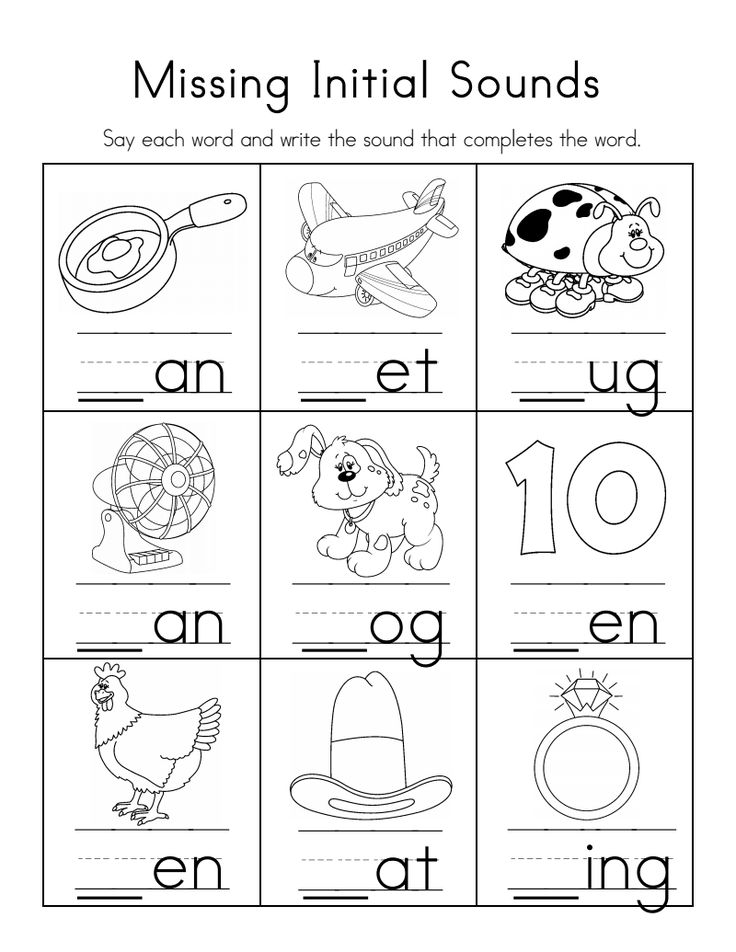 We will try not to fall into any pit, including this one, because it will not bring us anything good.
We will try not to fall into any pit, including this one, because it will not bring us anything good.
/One student writes on the board, the rest in notebooks./
- And now let's dress up the word in a carnival costume. / Draw sound designations in the form of circles in notebooks, ready-made circles from the set are attached to the board /.
- Do the words have the same number of sounds and letters? Why are there more sounds? /Children answer/
VI. Word transcribing exercises.
- Let's make a sound suit for the word "PIT", which is called TRANSCRIPTION. We have already met this word and we know what it means. But it will not be superfluous to repeat how sounds are indicated in the transcription. We will be helped in this by the "Page for the Curious", which is located in our textbook on p.48. Let's read / A student who reads well reads, the rest follow. /
- Now let's write the transcription in a notebook and on the board. Let's check. /[ y, ama]
Game "Find the mistake".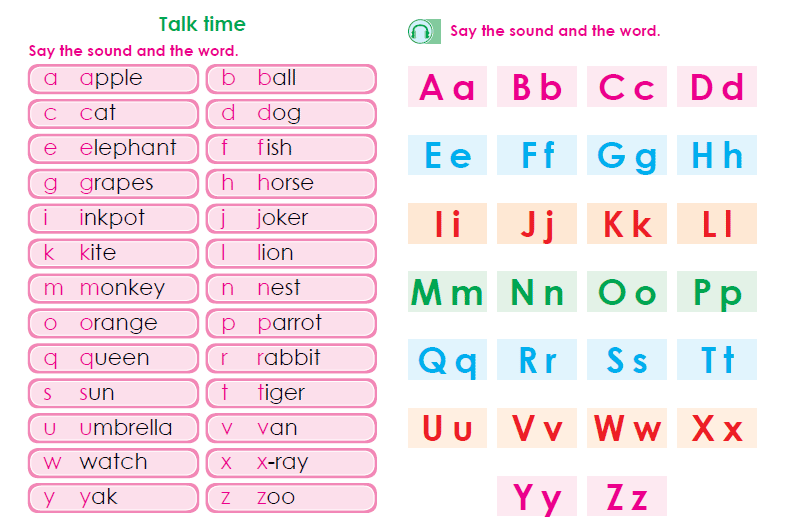 Pair work
Pair work
- Today we talked about floods. Melt water flows into the rivers, and from the rivers it enters the sea.
The teacher puts on the board cards with the words “SEA” and “WATER”
- You have two transcriptions for each word on your desks. Now you will work in pairs. You must consult and show the correct option. When you're ready, raise your hands in a handshake.
[mor,e] , [mor,e] , [vada] , [water]
- Well done. These are [mor, e] and [vada].
The teacher puts cards with the correct transcriptions on the board.
VII. Consolidation of the material covered.
Work in printed notebooks. p.24 #3
- Open PT on p. 24, #3. Consider drawings and sound designations of words (transcriptions): horse, whale, tiger, squirrel, seal. Replace sound designations with letters. Write down the words - the names of animals in a notebook.
/Children comment from their seats and write/.
VIII. Control and evaluation of knowledge.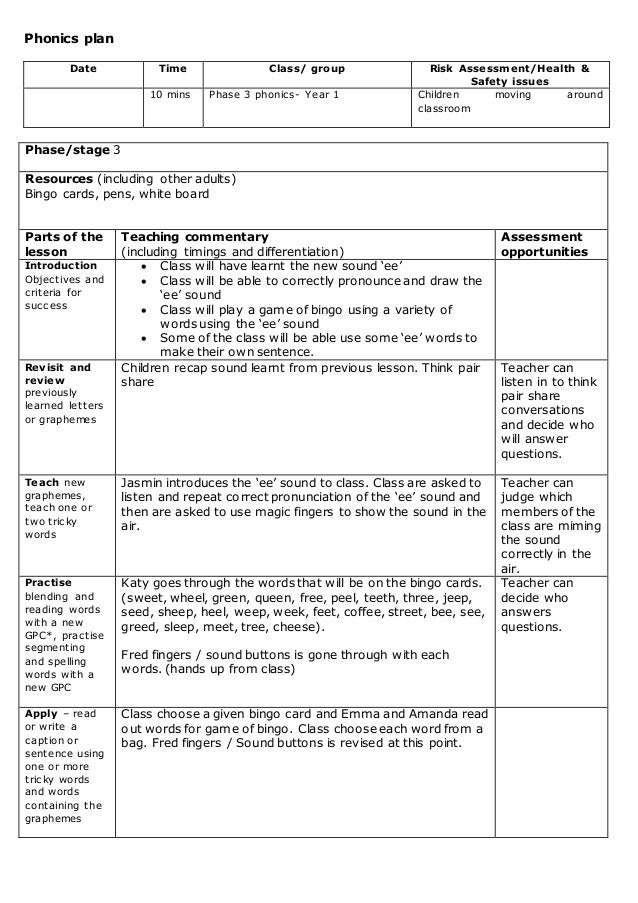
- Guys, today our whole lesson is somehow connected with water. People have been fishing in the water for centuries. And the old man in the fairy tale of A.S. Pushkin threw a seine into the sea and for the third time pulled out a seine with a goldfish. And what does the word "NEVOD" mean? /Children's answers/
- So we will now set up a net to catch the correct answers that represent goldfish.
- Here is our network.
The teacher attaches a table and 8 fishes to the magnetic board.
Each child has the same chart on their desk.
- And here are the fish. Having chosen the correct answer, we will find out in which cell the fish was “caught”, and we will put a cross there in those tablets that are on your desks. I will tell you two sentences, one of which will be correct. If the first sentence is correct, then you will put a cross in the top cell, and if the second sentence is correct, you will put a cross in the bottom cell.
Control tasks:
1.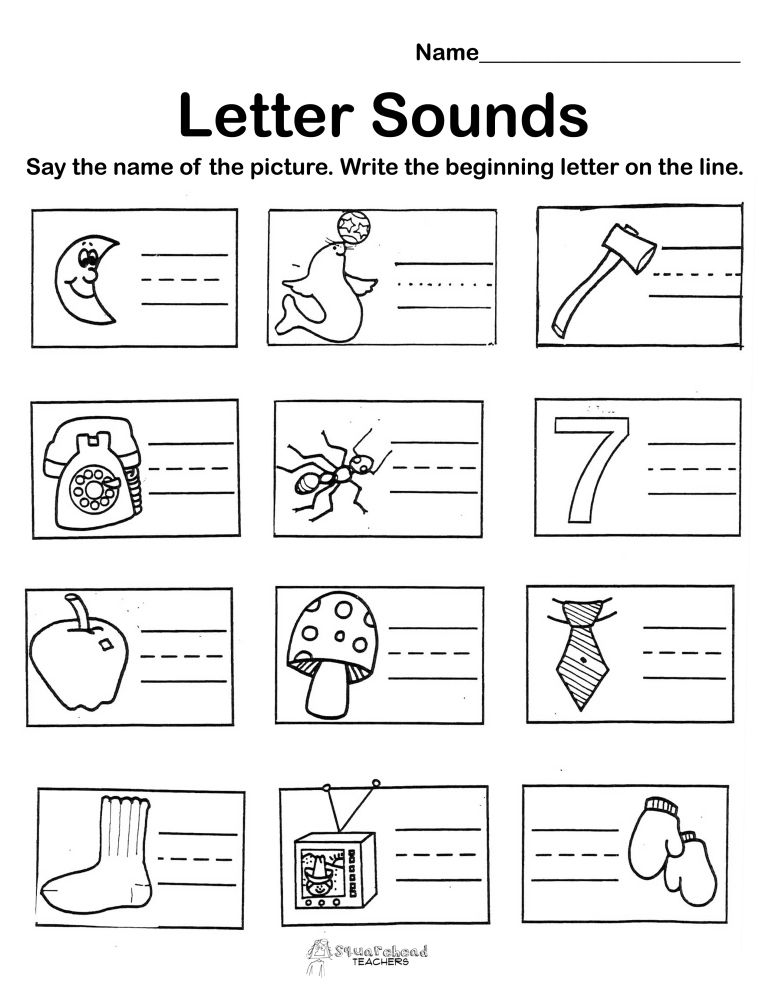 The sounds of speech are knocking, thunder, ringing, noise.
The sounds of speech are knocking, thunder, ringing, noise.
Speech sounds are vowels and consonants.
2. The sound can be heard and pronounced.
The letter can be heard and pronounced.
3. Vowel sounds can be stressed and unstressed.
Consonants are stressed and unstressed.
4. Consonants are deaf and voiced, hard and soft.
Vowels are deaf and voiced, hard and soft.
5. A vowel forms a syllable.
A consonant forms a syllable.
6. The stressed syllable in a word is pronounced weaker than others.
The stressed syllable in a word is pronounced more strongly than others.
7. Letters denote sounds in writing.
Letters are indicated by sounds.
8. The alphabet is all the letters in disorder.
The alphabet is all the letters in order.
Post-check showing correct answers on the board. A goldfish is attached to the cell with the correct answer.
IX. Final reflection.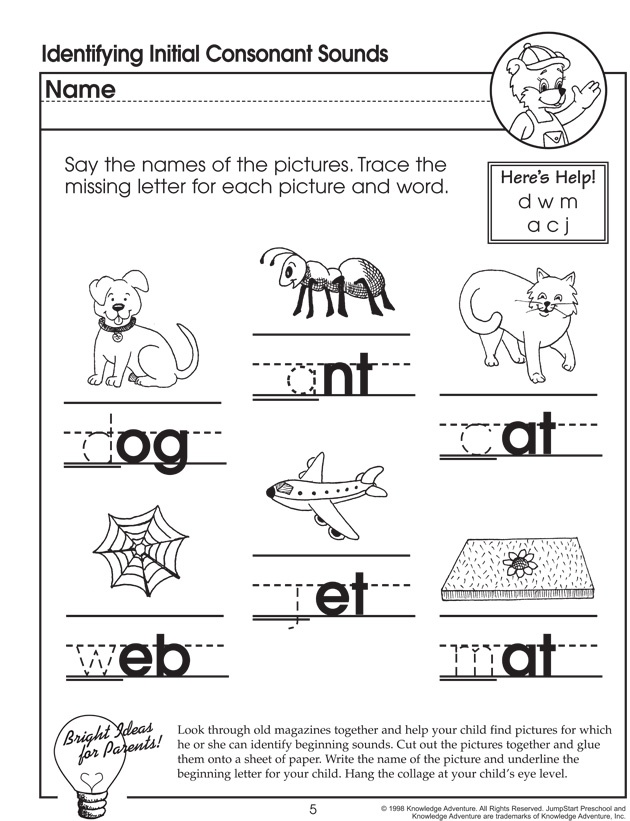
- So, guys, what is the basis of our speech, where does it all begin? /From sounds/.
- Sound, syllable, word, sentence, speech. All these are links in the same chain. They are connected. Working on sounds, we learn to speak correctly, beautifully, correctly express our thoughts, and in the future to write correctly.
- What did we do in today's lesson? /Children's answers/
- And now you have the opportunity to evaluate yourself. Draw two magic wands in your notebooks and rate yourself on two skills:
- work in notebooks, correct beautiful writing;
- can you distinguish sounds from letters, can you characterize sounds.
If the child does not experience any difficulties in the skill, then he puts a cross at the top of the stick, if he is not completely sure, then the cross is placed in the middle (above or below the middle), and if he is not at all sure - at the bottom of the stick.
- Did you like the lesson?
- What did you especially like about the lesson?
- What difficulties did you have
Sources used:
- Kanakina V.
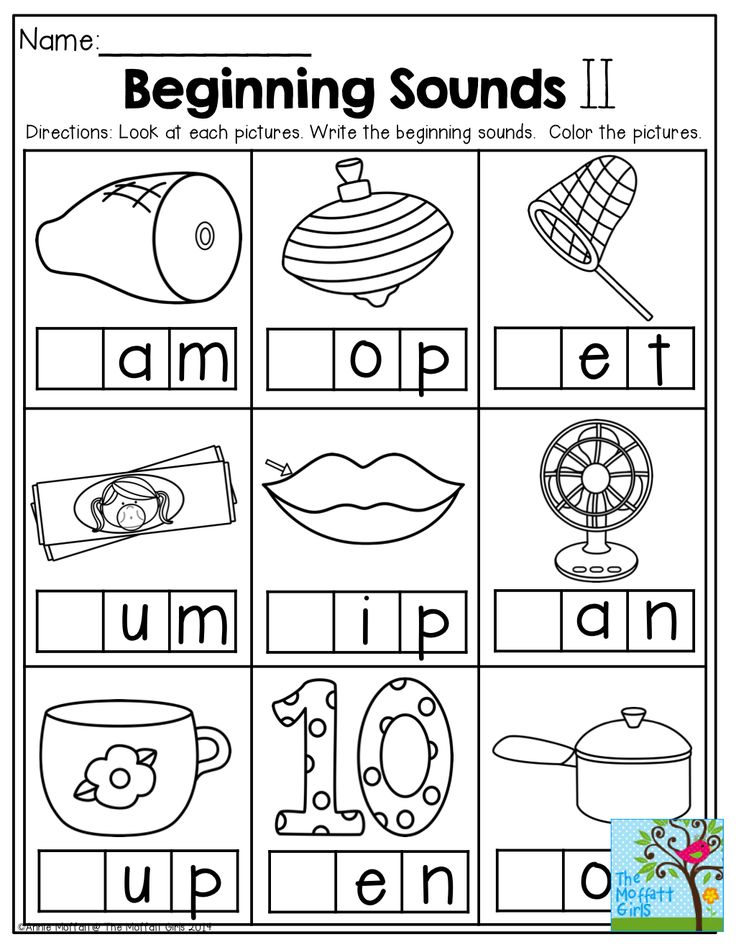 P. Russian language 1st grade. Methodological guide: M, "Prosveshchenie", 2011
P. Russian language 1st grade. Methodological guide: M, "Prosveshchenie", 2011 - I'm going to a lesson in an elementary school. Russian language. The book for the teacher. Compiled by M.A. Kozlova: M., "Olimp", 1998
- Kulnevich S.V., Lakotsenina T.P. Non-traditional lessons in elementary school. Part 2.: Voronezh, TC "Uchitel", 2002
- http://www.proshkolu.ru/user/cbljhbyf/file/2134597/
- http://matveyrybka.ucoz.ru/news/fizkultminutki_v_stikhakh/2011- 05-22-337
- http://detochki-doma.ru/fizkultminutki-v-nachalnoy-shkole/
Outline of the lesson "Sounds and Letters" | Outline of the lesson in the Russian language (grade 6):
Topic: Sounds and letters.
Lesson type: Lesson of learning and primary consolidation of new knowledge
Purpose:
To introduce children to the Russian alphabet and explain its meaning.
To consolidate children's ideas about vowels and consonants, sounds and letters, about their classification.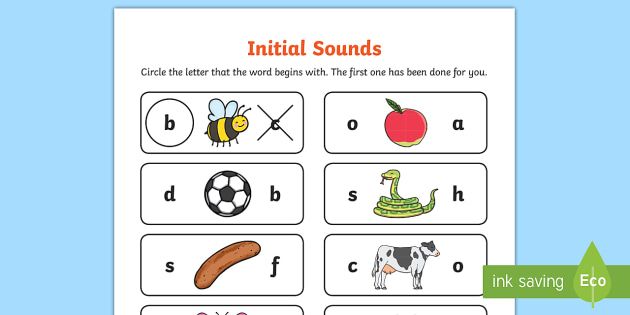
Practice copying skills from printed and cursive texts;
Improve calligraphic writing skills.
Continue working on vocabulary words.
Tasks:
Educational: to systematize students' knowledge of the alphabet;
to form the ability to use the alphabet.
Developing: formation of the ability to analyze sounding speech; development of speech, thinking, imagination;
Educators: to develop the skills of independent work, the ability to work in a group.
Expected results
Personal:
- a manifestation of a creative attitude to the learning process.
-understanding the reasons for success in learning activities.
Metasubject
Cognitive:
- students will learn to correctly name letters in alphabetical order;
- process received information, transform information from one form to another;
- evaluate one's actions, evaluate the result;
- find answers to questions using your life experience and information received in the lesson.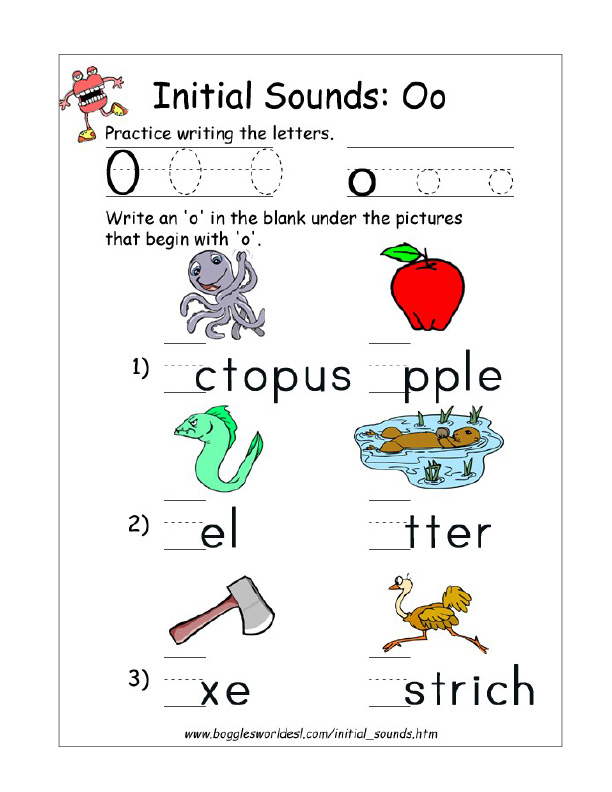
Regulatory
- determine the purpose of the activity in the lesson with the help of a teacher;
- to formulate a question, problem, difficulty faced by students; assess the current learning situation.
Communicative
- to listen and understand the speech of others;
- negotiate and come to a common decision in joint activities with classmates.
Subject
- mastering why the alphabet is needed and its role in people's lives;
- the ability to use the alphabet in practice, to correctly arrange words alphabetically;
Teaching methods:
explanatory and illustrative
search and research
Equipment:
- subject pictures: printed and capital letters, a card with the word GOOD, spelling dictionaries, a gnome with a spyglass GOOD READ, Smeshariki, alphabets Crimean Tatar, English.
- workbook;
Lesson progress.
1. Organizational moment
- Let's smile at each other.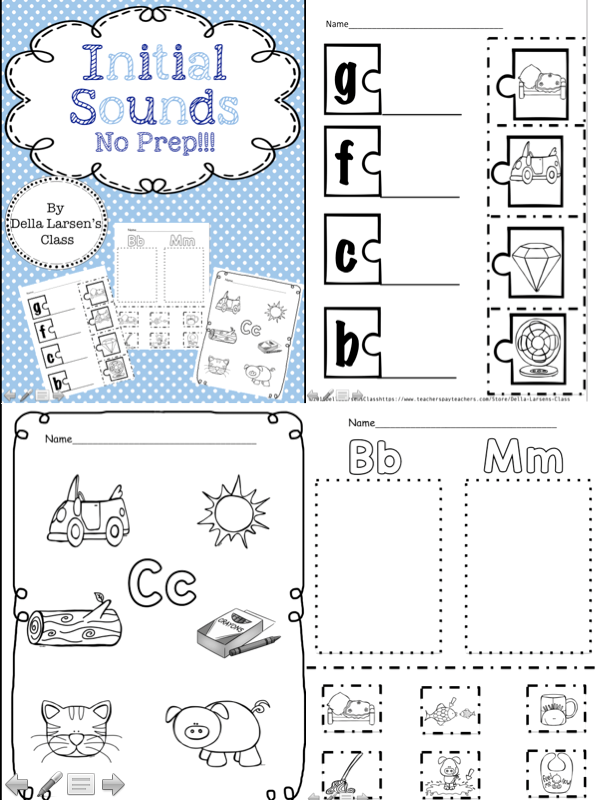 May today's lesson bring us all the joy of communication. Today in the lesson, guys, you will find many interesting tasks, new discoveries, and your assistants will be: attention, resourcefulness, ingenuity.
May today's lesson bring us all the joy of communication. Today in the lesson, guys, you will find many interesting tasks, new discoveries, and your assistants will be: attention, resourcefulness, ingenuity.
2. Self-determination for learning activities.
- To find out the topic of the lesson, guess the riddle
Letters - icons
Like fighters on the parade
In strict order
Lined up.
Everyone stands in the appointed place
.
And they are called… (alphabet)
Arrange the letters to make a word. (Alphabet)
-Who can formulate the topic of the lesson?
-That's right Today we have to repeat vowels and consonants and the letters denoting them, learn how to use the alphabet when performing various tasks and understand why we need to know the Russian alphabet.
3. A minute of calligraphy.
Write down the number, class work.
Now we have a minute of calligraphy.
- What is the task before us? (write beautifully).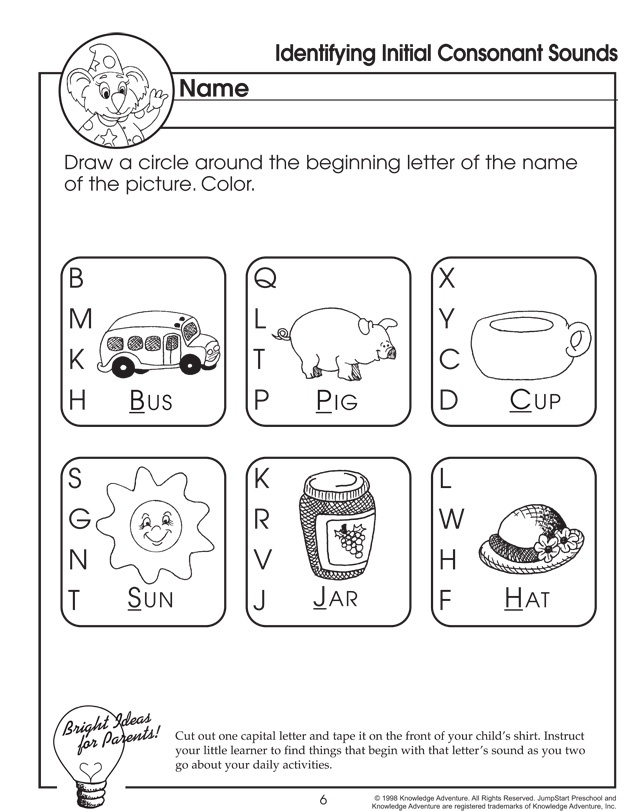
- What does "beautiful" mean? (observing the slope, the height of the letters, the distance, etc.).
- The game "Third extra"
- Name the letters that are written on the board. o x A
- Which one do you think is superfluous? (A-it is capital, lowercase)
- Form a syllable (CONSONANT + VOwel LETTER \u003d XO
4. Vocabulary work.
-We often say the word "good". What is the meaning of this word.
- Write the word in your notebook. OK.
Emphasize, underline dangerous places
. -Remember in this word the combination -oro-
-Come up with sentences with the word "good".
-Now let's work in groups.
-What do you see on the blackboard? (Individual words)
-What do you think the task will be?
- Make a sentence out of these words. Read.
-Write the sentence in your notebook.
(How good it is to be able to read!)
- Mutual check.
Leila will tell this poem and we will all listen carefully
5. Work on the topic of the lesson.
Work on the topic of the lesson.
1) Look through the window:
Now it's snowing, now it's raining.
This world is beautiful!
Everything will be fine!
-What dictionary word did we meet in the poem?
-Find this word in the spelling dictionary. What page is it on?
- Was it easy for you to find him?
-Could this task be completed faster? What do you need to know for this?
- All words in the dictionaries are in alphabetical order.
2) Where else is the alphabet used?
(Books in the library and student forms are in alphabetical order. The list of students is in the class magazine, in the hospital the patient cards are kept in alphabetical order. That's how important the alphabet is!)
3)-What is the alphabet? (Arrangement of letters in a certain order.)
- Do you think the alphabet and the alphabet are the same?
- is there an English, Tatar, Chuvash alphabet? You're right. How many languages exist, so many alphabets exist.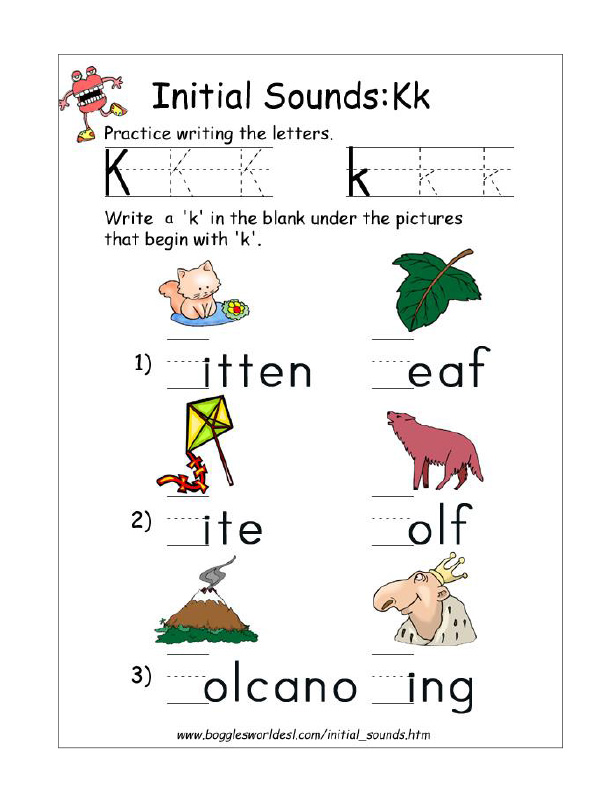
Fizminutka.
2) Russian alphabet.
- Let us dwell in more detail, of course, on the Russian alphabet. How many letters are in the Russian alphabet?
Total letters
Vowels
Consonants
Letters not representing sounds
33
10
21
2
33) How many vowels? (10) How many consonants? (21) How many letters that do not represent sounds? (2)
- Each letter has its place and its name. Let's read the alphabet in unison.
Exercise 1
- name the first 3 letters of the alphabet (A, B, C), 2 letters after the letter l (M, N), the letter that is between the letters p and s. (P)
- Name the letters, which do not represent sounds. (b, b)
Exercise on the electronic application. Find the place of the letter in alphabetical order.
5) Self-examination, evaluation of one's own work.
6) The game "Guess the word" COLLECTIVELY AT THE BOARD
The first letter of this word is in the alphabet after the letter "B", the second after the letter "H", the third - after "K", the last - after the letter "Y".

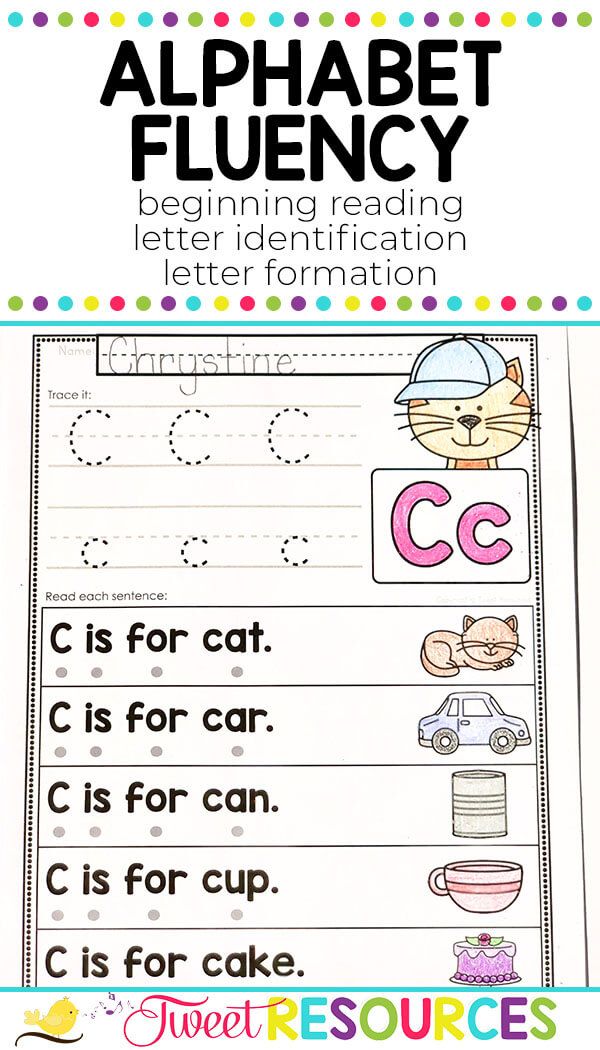
.jpg)
